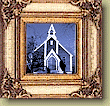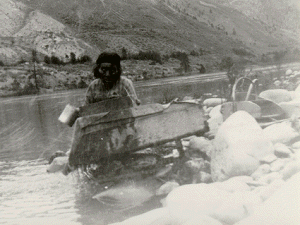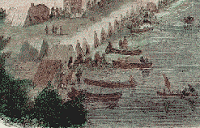
Town Tour
Architectural
Drawings
![]() St. John the Divine
St. John the Divine
![]() On Lee House
On Lee House
![]() Shilson House
Shilson House

|
| Native gold washing at Spences Bridge, 1899. (RBCM photo # 11403) |
Gold sat in the river bars of the Fraser for many thousands of years. Once the First Nations people of the area realized the value of this element to the British, they began to mine it and trade their gold for other supplies. The system was working well, but the presence of gold could not be kept a secret for long.
News of the Fraser gold travelled far and wide, causing a rush of miners to visit the Fort Yale region.
Many factors caused the secret to spread of gold on the Fraser. Some believe when the Hudson's Bay Company sent 800 ounces of gold to a mint in San Francisco, the miners in California learned of the gold in the mighty river. The California gold rush of 1849 had slowed considerably, and many of the miners were looking for another. R. C. Brown witnessed the scene of miners scurrying to prepare to leave San Francisco in a hurry, and said:
Never in the migration of men had there been seen such a rush, so sudden and so vast. (Lundin R. C. Brown. British Columbia - An Essay. p. 3)
The need for a town grew, and Fort Yale was converted to a town of seven to eight hundred people almost overnight.
The influx of visitors to this new frontier was virtually out of control. A correspondent for the British Columbia Gazette described Yale at this time.
There are probably 700 or 800 people here, nearly all of whom are miners, living in canvas tents, and waiting for the river to fall. The are five of six log houses in the place, and its inhabitants are orderly and well-conducted. (British Columbia Gazette.)

Tents by the Fraser, as they looked in 1858. (BC Archives: pdp01885)
The Fraser river gold rush made Fort Yale useful again, and gave it a new lease on life.
Almost abandoned years before, Fort Yale was in the middle of the activity. Its proximity to the river made it instantly useful again. The single wood building became a supply point for miners on Hill's bar, Boston bar and many others. Demand for town lots grew as fast as the miner could reach Yale. In 1859, Surveyor-General Joseph Pemberton was sent to survey town lots and have them sold.
Streets and town lots were created, and the town of Yale was born. To see how it looked in the 1860s go to the Town Maps page.
Home | Contents | Tour | People | Collection | Transportation | Just For Kids! | Team
|
Last updated 31 August 1998. This digital collection was produced under contract to the SchoolNet Digital Collections Program, Industry Canada. Produced by Schoolnet Digital Collections Team. |

|